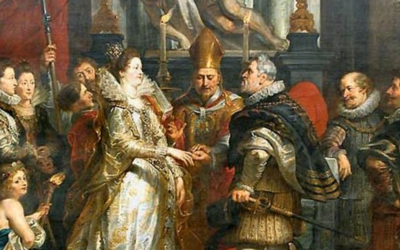On March 26, after a careful restoration, the Annunciation by Giovanni Balducci returned to its place in the Church of Santo Jacopo and Filippo in Scarperia.
It is back to shine and enchant again, thanks to an accurate restoration that made use of the analyses byArt-Test, this large painting on wood of the late sixteenth century, which had become almost illegible with the passage of time.
It is an Annunciation, attributed by the scholar Bruno Santi to a pupil of Naldini: Giovanni Balducci known as Cosci, an author perhaps little known today, but certainly appreciated at his time. He was indeed entrusted with some of the frescoes in the large cloister of Santa Maria Novella in Florence and some artworks in Rome in San Giovanni in Laterano and San Giovanni dei Fiorentini. After that he moved to Naples called by Cardinal Alfonso Gesualdo, where he ended his career and his life.
The Annunciation is set in the bedroom of the Virgin, where a monumental four-poster bed acts as background, with an unusual deep green curtain, and majestic architectural elements, which recall a Florentine stately home, with decorations in pietra serena, and a marble floor, painted by rigorously applying the rules of geometric perspective.
Also noteworthy are the Mannerist iridescences of the garments, which also re-emerged thanks to the restoration, and the detail of the basket with the sumptuous embroidery works.
During the restorations, last July, Art-Test to analyze this painting brought its instruments in that wonderful corner of Tuscany that is Mugello. The restoration site was set up by the restorer Stefano Garosi at the Compagnia di San Piero a Sieve, where several works had to be investigated. Between them, there was this large table, placed upside down, of which one could only partially sense the beauty.
Garosi showed us the conservation history of the work, the restorations of the past, the damage of a careless cleaning that had irreparably damaged the pictorial film and all the restoration phases already carried out to secure the work, remove the old repainting and consolidate the color.
Everyone should have the opportunity to discuss the characteristics of a painting by taking advantage of the great experience of those involved in its restoration. Each work reveals a very interesting story.
The reflectographic diagnostic campaign entrusted to Art–Test was intended to investigate whether there was an underlying compositional system, if there were pentimenti, and ultimately, the genesis of the work.

Detail of the Infra-Red reflectography performed on the work
At the inauguration, in front of a large audience, we explained that reflectography is a bit like the time machine, which takes us back in time and allows us to see what only the artist, and those living at his time could see.

We told how in this painting it was clear that the painter had a great mastery of drawing, which was done with a brush and using carbonaceous material. Some “pentimenti” are visible, related to the organization of spaces. In fact, the figure of the Virgin appears to be shifted slightly to the right today compared to the first thought, and her right shoulder, for the viewer, has been resized in the execution phase. Likewise also the left shoulder of the Angel Gabriel. In the foreground on the right, while the basket was perhaps painted in a last moment when the finished base can be glimpsed underneath. Perhaps it was added for a wish of the client.

Detail of the basket in InfraRed reflectography
To illustrate the artistic language was prof. Marco Pinelli who, in a few minutes, gave a clear and comprehensive picture of the stylistic references of the work, Tuscan Mannerism and the work of Andrea del Sarto.
The restorer Stefano Garosi illustrated the phases of the restoration and explained how images provided by Art-Test were useful to him, as details were visible that were not accessible to the naked eye.
The Mugello area is rich in art and is not new to restorations which include diagnostic investigations, there is a great attention to the area also due to the officers of the superintendency, in this case Dr. Jennifer Celani, and an always generous support by the Fondazione Cassa di Risparmio di Firenze.
It is a synergistic work that gives excellent results. At a time when we repeat like a mantra that “beauty will save the world” we should ask ourselves if the world will be able to save beauty.
We are confident of this, as long as there are those who will care and will protect art from the natural corruption of time and often from human neglect.




